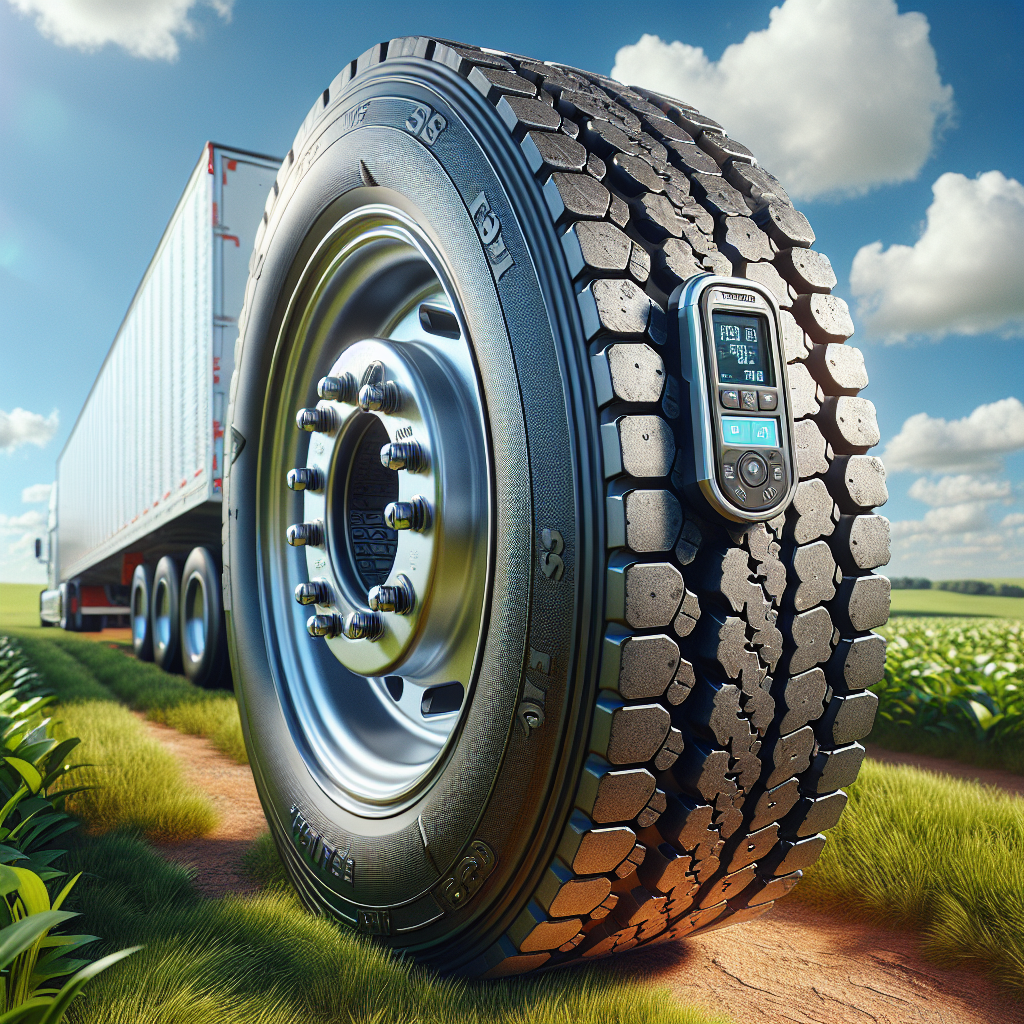Maintaining optimal tire pressure is crucial for ensuring the safety and performance of your trailer. Under-inflated tires can lead to increased wear and tear, reduced fuel efficiency, and a higher risk of blowouts. Conversely, over-inflated tires can result in poor handling and uneven tire wear. Therefore, having a reliable tire pressure monitoring system is essential for every trailer owner.
Modern tire pressure monitoring systems (TPMS) provide real-time data on tire pressures, allowing you to make informed decisions about your trailer's maintenance. Here are some key reasons why investing in the best tire pressure monitoring system for trailers is a smart choice:
- Enhanced Safety: Monitoring tire pressure helps prevent accidents caused by tire failure.
- Increased Longevity: Keeping tires inflated to the correct pressure extends their lifespan.
- Improved Fuel Efficiency: Proper tire pressure can lead to better gas mileage.
- Peace of Mind: Knowing your tires are in optimal condition allows you to focus on the road.
With the right monitoring system, you can easily track tire conditions and avoid potential hazards. Tow with peace of mind, knowing that trailerwatchdog is standing guard. Visit trailerwatchdog.com to learn more about our innovative solutions!
Key Features to Look for in a Tire Pressure Monitoring System
When searching for the best tire pressure monitoring system for trailers, it's essential to focus on features that will provide the most value and reliability. A good TPMS not only helps in monitoring tire pressure but also enhances safety and efficiency on the road. Here are some key features to consider:
- Real-Time Monitoring: The system should provide continuous, real-time readings of tire pressure and temperature, allowing for immediate action if issues arise.
- Alerts and Notifications: Look for a TPMS that sends alerts to your smartphone or dashboard when tire pressure is low or high, ensuring you stay informed at all times.
- Ease of Installation: A user-friendly installation process is vital. Choose a system that can be easily installed without requiring professional help.
- Durability and Weather Resistance: Ensure the sensors are built to withstand various weather conditions, including rain, snow, and extreme temperatures.
- Battery Life: Long-lasting battery life for sensors is crucial to minimize maintenance and ensure consistent monitoring.
- Compatibility: The TPMS should be compatible with your specific trailer type, whether it's a cargo trailer, RV, or utility trailer.
- Data Logging: Some advanced systems offer data logging, providing historical data on tire performance, which can help in identifying patterns and potential issues.
By focusing on these features, you can ensure that you select a tire pressure monitoring system that meets your needs and enhances the safety and efficiency of your trailer.
Top Rated Tire Pressure Monitoring Systems for Trailers

When it comes to selecting a tire pressure monitoring system for trailers, you want to ensure you're investing in a product that has proven reliability and positive user reviews. Here are some of the top-rated systems that stand out in the market:
- TPMS by TireMinder: This system is known for its user-friendly interface and real-time monitoring capabilities. It offers alerts for both low and high tire pressure, making it a favorite among trailer owners.
- EZ Tire TPMS: With a reputation for accuracy and durability, the EZ Tire system provides comprehensive monitoring and is particularly praised for its long battery life and easy installation process.
- iTPMS by TireSafe: This system features a sleek design and advanced features such as data logging and smartphone integration. Users appreciate its intuitive app that provides notifications and performance insights.
- Flow Through Sensors by Tire-Safe: These sensors allow for easy inflation without needing to remove them, making tire maintenance a breeze. Their robust build is designed for heavy-duty use.
- Tire-Sensor TPMS: This system offers excellent coverage for multiple trailers and comes equipped with a solar panel option for added convenience. Its ability to monitor multiple tire pressures simultaneously is a significant advantage.
Each of these tire pressure monitoring systems has been reviewed positively for their performance and reliability. Choosing from these top-rated options can help ensure your trailer remains safe and efficient on the road.
Benefits of Using a Tire Pressure Monitoring System

Integrating a tire pressure monitoring system (TPMS) into your trailer setup can offer a multitude of benefits that enhance safety, performance, and efficiency. Here are some key advantages:
- Enhanced Safety: Maintaining optimal tire pressure is crucial for safe towing. A TPMS alerts you to any pressure fluctuations, reducing the risk of blowouts and accidents.
- Improved Fuel Efficiency: Properly inflated tires reduce rolling resistance, which can lead to better fuel economy. By using a TPMS, you can monitor and maintain optimal tire pressure, ultimately saving on fuel costs.
- Extended Tire Life: Consistent monitoring helps prevent underinflation and overinflation, both of which can lead to accelerated tire wear. A TPMS helps ensure that your tires last longer, saving you money on replacements.
- Real-Time Monitoring: Many modern TPMS solutions provide real-time data, allowing you to receive immediate alerts about tire issues. This proactive approach enables you to address problems before they escalate into serious failures.
- Convenience: With a TPMS, you no longer have to manually check tire pressure before every trip. The system continuously tracks and reports on tire health, making it easier to stay informed.
By leveraging the technology of a tire pressure monitoring system, trailer owners can enjoy peace of mind, knowing they are taking steps to ensure both safety and efficiency on the road.
How to Install a Tire Pressure Monitoring System

Installing a tire pressure monitoring system (TPMS) on your trailer can be a straightforward process, especially with the right tools and guidance. Here’s a step-by-step guide to help you seamlessly integrate this essential safety feature:
- Choose the Right TPMS: Start by selecting a TPMS that suits your trailer's specifications and your personal preferences. Look for features such as real-time monitoring, ease of installation, and compatibility with your trailer type.
- Gather Required Tools: Before installation, ensure you have the necessary tools on hand. Commonly needed items include a wrench, screwdrivers, and possibly pliers, depending on the system you choose.
- Prepare the Tires: Begin by cleaning the valve stems on each tire to ensure a proper seal. This step is crucial for accurate pressure readings.
- Install the Sensors: Most TPMS kits come with sensors that need to be attached to the valve stems. Carefully follow the manufacturer's instructions to install each sensor securely. Some systems may require you to replace the valve stems altogether.
- Set Up the Monitor: Once the sensors are in place, install the monitor inside your vehicle. This device will display tire pressure data. Make sure it is easily visible and accessible while driving.
- Calibrate the System: After installation, calibrate the TPMS according to the manufacturer's guidelines. This may include inputting your trailer’s specifications or performing a pressure check.
- Test the System: Finally, take your trailer for a short drive to ensure that the TPMS is functioning correctly. Check the monitor for accurate readings and alerts.
With these steps, you can be confident that your tire pressure monitoring system is installed properly and ready to provide you with crucial data for safer towing.
Maintaining Your Tire Pressure Monitoring System for Longevity

To ensure the longevity and effectiveness of your tire pressure monitoring system (TPMS), regular maintenance is essential. A well-maintained TPMS not only enhances safety but also contributes to better fuel efficiency and tire longevity. Here are some key maintenance tips:
- Regularly Check Battery Life: Most TPMS sensors are battery-operated. Check the battery life periodically, and replace it as needed to avoid unexpected failures.
- Inspect Sensors for Damage: Routinely inspect the sensors for any signs of wear or damage. Look for cracks, corrosion, or any physical damage that could affect performance.
- Test the System: Perform regular tests of your TPMS to ensure it is accurately monitoring tire pressure. This can be done by manually checking tire pressure with a gauge and comparing it to the readings from the TPMS.
- Keep the System Clean: Dirt and debris can interfere with sensor readings. Keep the sensors clean by gently wiping them with a soft cloth, especially after driving on rough or muddy terrains.
- Update Firmware: If your TPMS has a digital display, check for firmware updates provided by the manufacturer. Keeping the system updated can improve functionality and add new features.
By following these maintenance tips, you can maximize the lifespan of your tire pressure monitoring system and ensure that it continues to provide reliable data. Tow with peace of mind, knowing that trailerwatchdog is standing guard.

